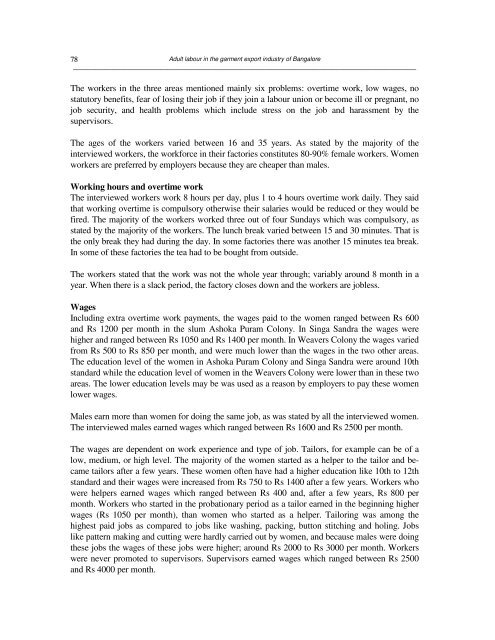You also want an ePaper? Increase the reach of your titles
YUMPU automatically turns print PDFs into web optimized ePapers that Google loves.
78<br />
Adult <strong>labour</strong> <strong>in</strong> <strong>the</strong> <strong>garment</strong> <strong>export</strong> <strong>in</strong>dustry <strong>of</strong> Bangalore<br />
──────────────────────────────────────────────────────────────────────────────────────────────<br />
The workers <strong>in</strong> <strong>the</strong> three areas mentioned ma<strong>in</strong>ly six problems: overtime work, low wages, no<br />
statutory benefits, fear <strong>of</strong> los<strong>in</strong>g <strong>the</strong>ir job if <strong>the</strong>y jo<strong>in</strong> a <strong>labour</strong> union or become ill or pregnant, no<br />
job security, <strong>and</strong> health problems which <strong>in</strong>clude stress on <strong>the</strong> job <strong>and</strong> harassment by <strong>the</strong><br />
supervisors.<br />
The ages <strong>of</strong> <strong>the</strong> workers varied between 16 <strong>and</strong> 35 years. As stated by <strong>the</strong> majority <strong>of</strong> <strong>the</strong><br />
<strong>in</strong>terviewed workers, <strong>the</strong> workforce <strong>in</strong> <strong>the</strong>ir factories constitutes 80-90% female workers. Women<br />
workers are preferred by employers because <strong>the</strong>y are cheaper than males.<br />
Work<strong>in</strong>g hours <strong>and</strong> overtime work<br />
The <strong>in</strong>terviewed workers work 8 hours per day, plus 1 to 4 hours overtime work daily. They said<br />
that work<strong>in</strong>g overtime is compulsory o<strong>the</strong>rwise <strong>the</strong>ir salaries would be reduced or <strong>the</strong>y would be<br />
fired. The majority <strong>of</strong> <strong>the</strong> workers worked three out <strong>of</strong> four Sundays which was compulsory, as<br />
stated by <strong>the</strong> majority <strong>of</strong> <strong>the</strong> workers. The lunch break varied between 15 <strong>and</strong> 30 m<strong>in</strong>utes. That is<br />
<strong>the</strong> only break <strong>the</strong>y had dur<strong>in</strong>g <strong>the</strong> day. In some factories <strong>the</strong>re was ano<strong>the</strong>r 15 m<strong>in</strong>utes tea break.<br />
In some <strong>of</strong> <strong>the</strong>se factories <strong>the</strong> tea had to be bought from outside.<br />
The workers stated that <strong>the</strong> work was not <strong>the</strong> whole year through; variably around 8 month <strong>in</strong> a<br />
year. When <strong>the</strong>re is a slack period, <strong>the</strong> factory closes down <strong>and</strong> <strong>the</strong> workers are jobless.<br />
Wages<br />
Includ<strong>in</strong>g extra overtime work payments, <strong>the</strong> wages paid to <strong>the</strong> women ranged between Rs 600<br />
<strong>and</strong> Rs 1200 per month <strong>in</strong> <strong>the</strong> slum Ashoka Puram Colony. In S<strong>in</strong>ga S<strong>and</strong>ra <strong>the</strong> wages were<br />
higher <strong>and</strong> ranged between Rs 1050 <strong>and</strong> Rs 1400 per month. In Weavers Colony <strong>the</strong> wages varied<br />
from Rs 500 to Rs 850 per month, <strong>and</strong> were much lower than <strong>the</strong> wages <strong>in</strong> <strong>the</strong> two o<strong>the</strong>r areas.<br />
The education level <strong>of</strong> <strong>the</strong> women <strong>in</strong> Ashoka Puram Colony <strong>and</strong> S<strong>in</strong>ga S<strong>and</strong>ra were around 10th<br />
st<strong>and</strong>ard while <strong>the</strong> education level <strong>of</strong> women <strong>in</strong> <strong>the</strong> Weavers Colony were lower than <strong>in</strong> <strong>the</strong>se two<br />
areas. The lower education levels may be was used as a reason by employers to pay <strong>the</strong>se women<br />
lower wages.<br />
Males earn more than women for do<strong>in</strong>g <strong>the</strong> same job, as was stated by all <strong>the</strong> <strong>in</strong>terviewed women.<br />
The <strong>in</strong>terviewed males earned wages which ranged between Rs 1600 <strong>and</strong> Rs 2500 per month.<br />
The wages are dependent on work experience <strong>and</strong> type <strong>of</strong> job. Tailors, for example can be <strong>of</strong> a<br />
low, medium, or high level. The majority <strong>of</strong> <strong>the</strong> women started as a helper to <strong>the</strong> tailor <strong>and</strong> became<br />
tailors after a few years. These women <strong>of</strong>ten have had a higher education like 10th to 12th<br />
st<strong>and</strong>ard <strong>and</strong> <strong>the</strong>ir wages were <strong>in</strong>creased from Rs 750 to Rs 1400 after a few years. Workers who<br />
were helpers earned wages which ranged between Rs 400 <strong>and</strong>, after a few years, Rs 800 per<br />
month. Workers who started <strong>in</strong> <strong>the</strong> probationary period as a tailor earned <strong>in</strong> <strong>the</strong> beg<strong>in</strong>n<strong>in</strong>g higher<br />
wages (Rs 1050 per month), than women who started as a helper. Tailor<strong>in</strong>g was among <strong>the</strong><br />
highest paid jobs as compared to jobs like wash<strong>in</strong>g, pack<strong>in</strong>g, button stitch<strong>in</strong>g <strong>and</strong> hol<strong>in</strong>g. Jobs<br />
like pattern mak<strong>in</strong>g <strong>and</strong> cutt<strong>in</strong>g were hardly carried out by women, <strong>and</strong> because males were do<strong>in</strong>g<br />
<strong>the</strong>se jobs <strong>the</strong> wages <strong>of</strong> <strong>the</strong>se jobs were higher; around Rs 2000 to Rs 3000 per month. Workers<br />
were never promoted to supervisors. Supervisors earned wages which ranged between Rs 2500<br />
<strong>and</strong> Rs 4000 per month.


















